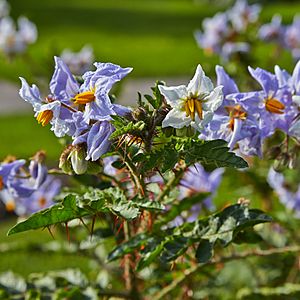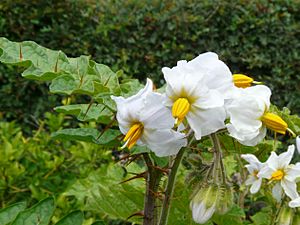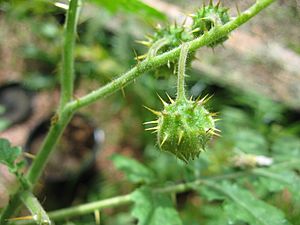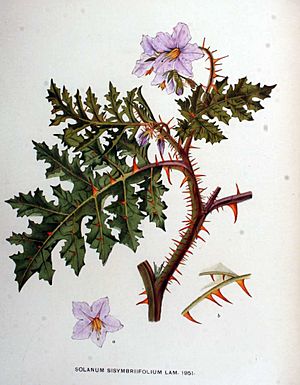Solanum sisymbriifolium facts for kids
Quick facts for kids Solanum sisymbriifolium |
|
|---|---|
 |
|
| Scientific classification | |
| Genus: |
Solanum
|
| Species: |
sisymbriifolium
|
| Synonyms | |
|
Many, see text |
|
The Solanum sisymbriifolium is a cool plant with many names! People often call it vila-vila, sticky nightshade, red buffalo-bur, the fire-and-ice plant, or litchi tomato. It's a type of plant that grows small, tasty fruits.
These fruits are red on the outside and yellow inside. They grow inside a spiny, green cover. You know the fruit is ready to eat when it easily comes off the stem. The taste is a bit like sour cherries and also a little like a tomato.
This plant is super useful! Farmers sometimes use it to protect their potatoes. It acts like a "trap crop," which means it attracts tiny worms called potato cyst nematodes away from the potatoes. The stems and leaves of the plant have a special chemical called solasodine. This chemical helps the plant fight off many pests and diseases. But watch out! It's not safe from Colorado potato beetles or tomato hornworms. Because it has lots of sharp prickles, people also plant it as a hedge to keep animals out of gardens.
Contents
What is its scientific name?
The sticky nightshade has had many different scientific names over time. Sometimes, these names were confusing because they were used for other plants too. Here are some of the older names that are not used anymore:
- Solanum balbisii
- Solanum bipinnatifidum
- Solanum brancaefolium
- Solanum decurrens
- Solanum edule
- Solanum formosum
- Solanum inflatum
- Solanum mauritianum (this name was already taken by another plant)
- Solanum opuliflorum
- Solanum rogersii
- Solanum sabeanum
- Solanum subviscidum
- Solanum thouinii
- Solanum viscidum
- Solanum viscosum
- Solanum xanthacanthum
Scientists also tried to name different types or forms of the plant. But today, these are usually seen as the same plant. Some of these old names include:
- Solanum sisymbriifolium var. purpureiflorum
- Solanum sisymbriifolium forma albiflorum
- Solanum sisymbriifolium var. bipinnatipartitum
- Solanum sisymbriifolium var. brevilobum
- Solanum sisymbriifolium var. gracile
- Solanum sisymbriifolium var. heracleifolium
- Solanum sisymbriifolium forma lilacinum
- Solanum sisymbriifolium var. macrocarpum
- Solanum sisymbriifolium var. oligospermum
Where does it grow?
Native Home
The sticky nightshade first came from South America. You can find it naturally in:
- Argentina, Bolivia, Chile, Colombia, Ecuador, Paraguay, Peru
- Brazil, especially in a state called Rio Grande do Sul
Where it has spread
This plant has traveled to many other parts of the world! It was brought to these places by people and now grows there too:
Europe
- Austria, Belgium, Czech Republic, Denmark, Ireland, Estonia, Finland, France, Germany, Hungary, Latvia, Lithuania, Morocco, Netherlands, Norway, Portugal, Spain, Sweden, Ukraine, United Kingdom
- Italy, especially on the island of Sicily, where it can sometimes grow too much.
Asia
- Republic of Korea
- Bangladesh
- Taiwan
- Japan
- Turkey
- India, in the state of Gujarat
- China, in the areas of Guangdong and Yunnan
Africa
North America
- Canada
- Mexico
- United States: It can grow in about 64% of the country. It's not expected to grow in most of Alaska, Montana, or Wisconsin. It will probably never grow in North Dakota.
- You can find it in Alabama, Arizona, California, Delaware, Florida, Georgia, Iowa, Louisiana, Massachusetts, Mississippi, New Jersey, New York, North Carolina, Oregon, Pennsylvania, South Carolina, and Texas.
- It is NOT found in Idaho.
Oceania
- Australia, in the states of New South Wales, Victoria, and Western Australia
- New Zealand
See also
 In Spanish: Revienta Caballos para niños
In Spanish: Revienta Caballos para niños




